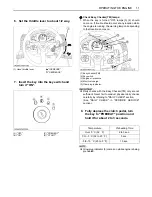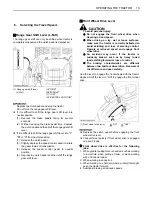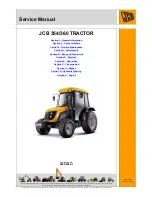
OPERATING THE TRACTOR
18
B
Brake Pedals (Right and Left)
To avoid personal injury:
A
Applying only one rear wheel brake at high
speeds could cause the tractor to swerve or
roll-over.
To avoid personal injury:
A
An accident may occur if the tractor is
suddenly braked, such as by heavy towed
loads shifting forward or loss of control.
A
The braking characteristics are different
between two and four wheel drive. Be aware of
the difference and use carefully.
A
When driving on icy, wet or loose surfaces,
make sure the tractor is correctly ballasted to
avoid skidding and loss of steering control.
Operate at reduced speed.
1. Before operating the tractor on the road or before
applying the parking brake, be sure to interlock the
right and left pedals as illustrated below.
2. Use individual brakes to assist in making sharp turns
at slow speeds (Field Operation Only). Disengage the
brake pedal lock and depress only one brake pedal.
3. Be sure brake pedals have equal adjustment when
using locked together.
B
Clutch Pedal
To avoid personal injury:
A
Sudden release of the clutch may cause the
tractor to lunge in an unexpected manner.
The clutch is disengaged when the clutch pedal is fully
pressed down.
To help prevent premature clutch wear:
A
The clutch pedal must be quickly disengaged and
be slowly engaged.
A
Avoid operating the tractor with your foot resting on
the clutch pedal.
A
Select proper gear and engine speed depending
on the type of job.
3. Checking the brake pedal.
(1) Brake pedal lock
(A) "LOCK"
(B) "RELEASE"
4. Raise the implement.
(See "HYDRAULIC UNIT" section.)
(1) Hydraulic control lever
(A) "UP"
5. Depress the Clutch Pedal.
(1) Clutch pedal
Summary of Contents for B3300SU
Page 4: ......
Page 14: ...SAFE OPERATION 6 7 DANGER WARNING AND CAUTION LABELS...
Page 15: ...7 SAFE OPERATION...
















































